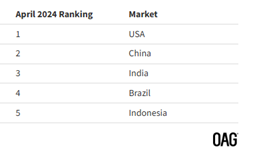Table of Contents
An Air India Airbus A320 aircraft bound for Hyderabad mistakenly entered a parallel taxiway instead of the main runway at Goa’s Mopa airport. The crew had to reject the takeoff, an incident categorized as “runway confusion.” The Directorate General of Civil Aviation (DGCA) is expected to blame the pilots, a recurring pattern in Indian aviation.
| Historical Context of Runway Confusion in India |
India has witnessed numerous incidents of runway confusion:
Runway Overrun and Landing Incidents in IndiaIndia has experienced frequent high-speed approaches and runway overruns since 2005:
|
What is The Potential of the Aviation Sector In India?
- India’s domestic airline capacity has nearly doubled, with an annual growth rate of 6.9% between 2014 and 2024.
- India is the 3rd-largest domestic aviation market in the world, after the United States and China.
- The sector will require substantial investments, with estimates suggesting over $170 billion needed through 2030 to fund aircraft acquisitions and airport infrastructure enhancements.

What are the Challenges Associated?
- Aviation Turbine Fuel (ATF) Prices: ATF constitutes a substantial portion of an airline’s operating expenses.
- In India, ATF prices are among the highest globally due to elevated base prices and state-level taxes.
- Despite industry appeals, ATF remains outside the Goods and Services Tax (GST) regime, leading to non-uniform taxation across states.
- Airport Capacity: Major airports, especially in metropolitan areas, face capacity constraints, leading to congestion and delays.
- This congestion affects operational efficiency and passenger experience.
- Regional Connectivity: While initiatives like the UDAN scheme aim to enhance regional connectivity, challenges persist in terms of infrastructure development and the financial viability of operations to smaller airports.
- Debt Burden: Many Indian airlines operate under significant debt, affecting their ability to maintain safety standards and invest in growth.
- The financial strain has led to the insolvency of major carriers in the past, raising concerns about the industry’s stability.
- Eg., In May 2023, Go First (Formerly GoAIR) filed for bankruptcy, citing financial challenges exacerbated by engine supply issues.
- Profitability Pressures: Even leading airlines face profitability challenges due to rising expenses.
- Eg., IndiGo reported a profit decline attributed to increased operating costs, including a 23% surge in fuel expenses.
- Pilot Fatigue: Reports indicate that pilot fatigue is a significant concern, exacerbated by demanding schedules and insufficient rest periods.
- Pilots face pressure to meet “On-Time Performance” (OTP) targets.
- Fatigue and overworking lead to decision-making errors in critical situations.
- Eg., The Kozhikode and Mangaluru crashes, where captains disregarded co-pilot warnings due to time pressures.
- Skill Shortages: The rapid expansion of the aviation sector has led to a demand-supply gap in skilled personnel, including pilots, engineers, and ground staff.
- Eg., Airline training programs fail to adequately prepare pilots for real-world challenges, including proper runway markings and stabilized approach criteria.
- Global Economic Factors: Fluctuations in global oil prices, currency exchange rates, and geopolitical tensions can adversely impact the Indian aviation industry.
| Government Initiatives for the Aviation Sector in India |
|
Way Forward
- Fuel Diversification: Promote the adoption of biofuels to reduce reliance on traditional Aviation Turbine Fuel (ATF) and mitigate the impact of high import taxes. Implement fuel hedging strategies to manage price volatility, drawing inspiration from international best practices.
- Enhancing Revenue Streams: Develop ancillary revenue sources such as cargo services, in-flight sales, and premium offerings to strengthen profitability.
- Optimised Pricing Strategies: Leverage advanced yield management systems to optimise pricing, ensuring profitability without engaging in harmful price wars. Strengthen customer loyalty programs to drive repeat business and reduce dependency on aggressive pricing tactics.
- Regulatory Improvements: Push for regulatory reforms that foster the entry of new players and curb monopolistic behaviors within the aviation sector.
- Route Optimisation: Encourage airlines to operate on under-served routes, enhancing competition and providing more travel options to passengers. Opt for aircraft leasing to maintain operational flexibility and reduce the financial burden of owning fleets.
- Sustainable Practices: Introduce carbon offset initiatives, such as the ICAO Carbon Emissions Calculator (ICEC), to monitor and mitigate the aviation industry’s environmental impact.


 Dynamic Pricing: What It Is and Why It's...
Dynamic Pricing: What It Is and Why It's...
 SSC MTS Salary 2025, Check Highest Salar...
SSC MTS Salary 2025, Check Highest Salar...
 F-35 Fighter Jet Stranded in Kerala: Dis...
F-35 Fighter Jet Stranded in Kerala: Dis...





















